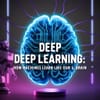Deep learning is a subset of machine learning that enables machines to learn from large amounts of data, similar to how our brains process information. It's inspired by the structure and function of the human brain, using artificial neural networks to recognize patterns and make decisions.
At its core, deep learning involves feeding large datasets into these neural networks, which consist of multiple layers. Each layer processes and transforms the data, allowing the system to learn complex patterns. For instance, in image recognition tasks, initial layers might detect edges or colors, while deeper layers recognize shapes or objects.
Neural networks are the powerhouse of deep learning. They consist of an input layer, hidden layers, and an output layer. The input layer receives raw data, hidden layers perform computations, and the output layer produces the final result. These networks can automatically learn features from data, eliminating the need for manual feature engineering.
- Chatbots and Virtual Assistants: Deep learning enables machines to understand and respond to human language, powering chatbots like ChatGPT and voice assistants like Siri.
- Image Recognition: Deep learning models can recognize objects, faces, and scenes, with applications in self-driving cars, facial recognition, and medical diagnosis.
- Speech Recognition: Deep learning algorithms can transcribe spoken language, enabling voice-controlled interfaces and transcription services.
While both deep learning and machine learning are subsets of artificial intelligence, they differ significantly in their approaches. Machine learning relies on human-defined features and structured data, whereas deep learning uses neural networks to automatically extract features from unstructured data like images, audio, and text.³
Deep learning has transformed industries, from healthcare and finance to transportation and education. Its applications continue to grow, with potential innovations in areas like biologically inspired models, unsupervised learning, and hybrid models combining traditional machine learning with deep learning.


